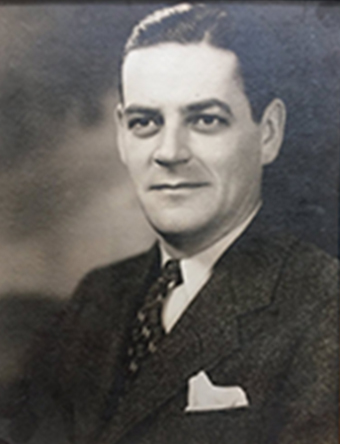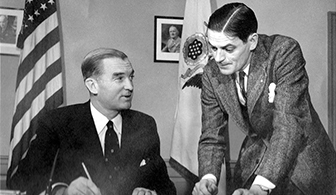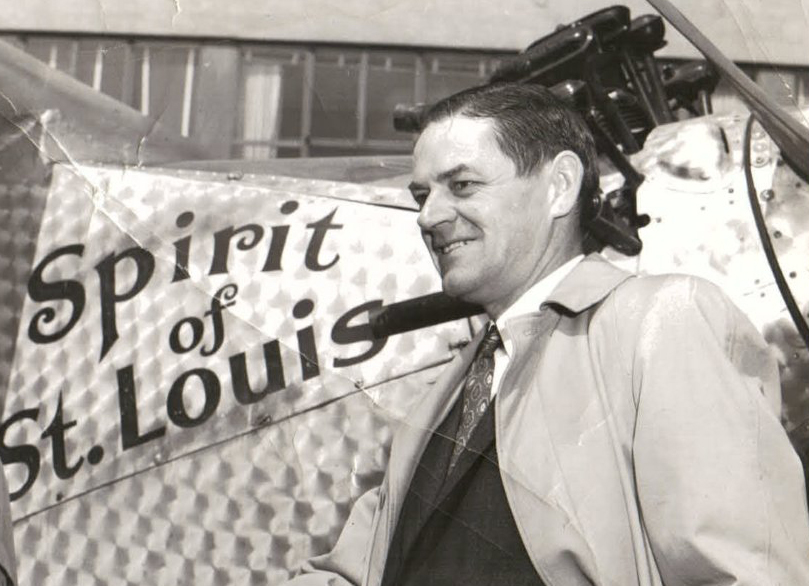

“As instrumental as anyone in creating the Air Force.”
That description of Stephen F. Leo, the first Director of Air Force
Public Relations, came from someone who would know: the United States
Senator from Missouri, Stuart Symington, who before he became a
senator was also, of course, the first Secretary of the Air Force. Mr.
Symington said that “everybody who believes in air power and a great
Air Force owes a debt to Steve Leo.”

Before World War II, Mr. Leo was a reporter and editor with the
Gannett newspaper chain. Going from journalism to public service, he
became the Executive Secretary to the Governor of Maine, who then
appointed him as Chairman of the Maine State Liquor Commission.
Donning a uniform during World War II, he served in the
China-Burma-India theater, and was a military attache to the Truman
Senate Committee investigating war contracts.
As a
civilian after the war, but before the Air Force officially became a
separate service, Mr. Leo wrote a plan outlining public and
congressional relations strategy for the fledgling military branch. He
spent 1946 in Berlin, Germany on the staff of the American Military
Government, but was recalled the following year when Mr. Symington
became the first Secretary of the Air Force and appointed him to be
the Air Force’s first Director of Public Relations.
After three very consequential years in that role, developing the
principles that continue to guide Air Force public affairs to this
day, Mr. Leo became the Special Assistant to the Chairman of the
National Security Resources Board. He later headed the Washington
office of Sverdrup and Parcel, a professional services company that
operated Arnold Engineering Development Center in Tennessee under
contract to the Air Force. In 1960, when Senator Symington ran against
Senator John Kennedy for the Democratic nomination for president, he
once again called on Mr. Leo for help, making him the campaign’s press
secretary.
A profile of Mr. Leo as a presidential campaign press agent is
here.


Mr. Leo's contributions to the development of the Air Force and to Air Force Public Affairs are legion. Volume Number One of the "Headquarters Public Relations Letter" — which you can read here — provides insight into Mr. Leo's public relations philosophy. Under his leadership, the Air Force originally organized the public affairs and legislative liaison functions into one combined department. For a perspective on the organization of Air Force public affairs in its early years, you may find this brief history — "The Information Program Through The Years" — interesting.

According to those who worked with him, Mr. Leo was particularly
talented handling political issues. Col W.C. Robinson, who worked for
him, said "... he was probably the smartest man I ever knew ... but,
he suffered no fools." His approach to public relations was not
without controversy. David Lawrence, the conservative syndicated
columnist and founder of US News and World Report magazine,
wrote about Mr. Leo's very effective PR campaign
in the tough, very political "roles and mission" competition among the
services, particularly between the Navy and the newest service, the
Air Force. While far from a fan of the Air Force's position, Lawrence
grudgingly acknowleged Mr. Leo's savvy, calling him a "propagandist",
but also "the best ghost writer of speeches" in Washington.
A much different perspective came from another Washington
columnist, Guy Richards,
who was impressed that Mr. Leo was as adept at keeping things out of
the press as he was getting them in.
Mr. Leo retired from Sverdrup and Parcel in 1969, and returned to his
native Maine. In retirement, he served as a director of the alumni
fund of his alma mater, Bowdoin College. He passed away in 1983.
You can read his obituary here.